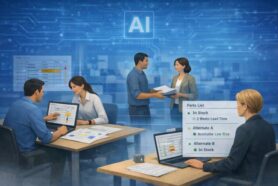
Digital thread importance is growing in manufacturing businesses. The digital thread has emerged as a critical concept for achieving seamless integration across the entire product lifecycle. The digital thread refers to the communication framework that integrates data throughout a product’s lifecycle, from design through manufacturing and beyond. This connected, integrated flow of data ensures that every aspect of the product development and production process is synchronized, leading to enhanced collaboration, improved accuracy, and more efficient operations. For manufacturing businesses, adopting a digital thread is not just a competitive advantage—it’s becoming a necessity to thrive in a complex and ever-evolving market.
At OpenBOM, we are focusing on how to provide a scalable data management platform to connect multiple silos of information through the different stages of product lifecycle and multiple systems. Let’s discuss how OpenBOM helps.
Digital Thread Architecture Explained
Building a robust digital thread requires an architecture that can support flexible structures and links between various systems and data points. Unlike traditional linear models, a digital thread architecture is designed to be dynamic, adapting to the specific needs of the business as it evolves. This flexibility allows companies to create, modify, and maintain connections between disparate systems, such as CAD, PDM, PLM, ERP, and MES, ensuring that data flows smoothly across the entire organization.
At the core of this architecture is the concept of creating a system of flexible structures (aka BOM) and links (to information located elsewhere). Together these structures create a product lifecycle twin.
This approach enables businesses to tailor their digital thread to fit their unique processes and workflows. Instead of being constrained by rigid, predefined paths, companies can define their own connections and dependencies, allowing for greater agility and responsiveness to changes in the market or technology landscape.
How OpenBOM Supports Link Building with xBOM Services
OpenBOM’s xBOM services play a crucial role in enabling businesses to build and maintain their digital thread. By offering flexible xBOM Types and a customizable data model, OpenBOM allows companies to create live links between different systems and datasets, ensuring that data remains consistent and up-to-date across the entire product lifecycle.
One of the key differentiators of OpenBOM’s xBOM services is its ability to support multiple BOM (Bill of Materials) types, such as EBOM (Engineering BOM), MBOM (Manufacturing BOM), and SBOM (Service BOM). This flexibility allows businesses to create BOMs that are tailored to their specific needs, whether they are focused on design, production, or maintenance.
Additionally, OpenBOM’s customizable data model enables companies to define their own data structures, attributes, and relationships, creating a truly personalized digital thread.
The flexible data structure builds a product knowledge graph that connects all elements of data.
The live links between different BOMs and data points ensure that any changes made in one area are automatically reflected across the entire system, reducing the risk of errors and improving overall efficiency.
Technological Advantages of OpenBOM
OpenBOM’s unique architecture offers several technological advantages that set it apart from other solutions on the market. These include:
- Graph Database Usage: OpenBOM leverages a graph database to manage the complex relationships between different data points. This allows for more efficient data retrieval, better performance, and the ability to handle complex, interconnected datasets with ease.
- Flexible Reference-Instance Data Model for xBOM: The reference-instance data model used by OpenBOM provides the flexibility needed to manage various BOM types and their relationships. This model allows for the creation of instances for items used in multiple structures yet eliminates duplications and ensures consistency across different projects and products.
- Multi-Tenant Architecture: OpenBOM’s multi-tenant architecture enables businesses to connect multiple applications and companies within a single ecosystem. This is particularly beneficial for organizations that work with external partners, suppliers, or customers, as it allows for seamless data sharing and collaboration across different entities.
- Open REST API: OpenBOM’s open REST API provides businesses with the flexibility to integrate with a wide range of third-party applications and systems. This ensures that companies can build their digital thread using the tools that best fit their needs, without being locked into a single vendor or platform.
Conclusion: OpenBOM’s Unique Architecture for Building a Digital Thread
OpenBOM’s unique architecture provides a robust technological foundation for building a digital thread that spans multiple companies and multiple engineering and manufacturing tools. By leveraging a graph database, a flexible reference-instance data model, a multi-tenant architecture, and an open REST API, OpenBOM enables businesses to create a dynamic, interconnected system that supports seamless data flow across the entire product lifecycle. With OpenBOM, manufacturing companies can achieve the agility, accuracy, and efficiency needed to stay competitive in today’s market, making it an indispensable tool for modern product development and production.
REGISTER FOR FREE and explore more information about how OpenBOM can help you.
Best, Oleg
Join our newsletter to receive a weekly portion of news, articles, and tips about OpenBOM and our community.










